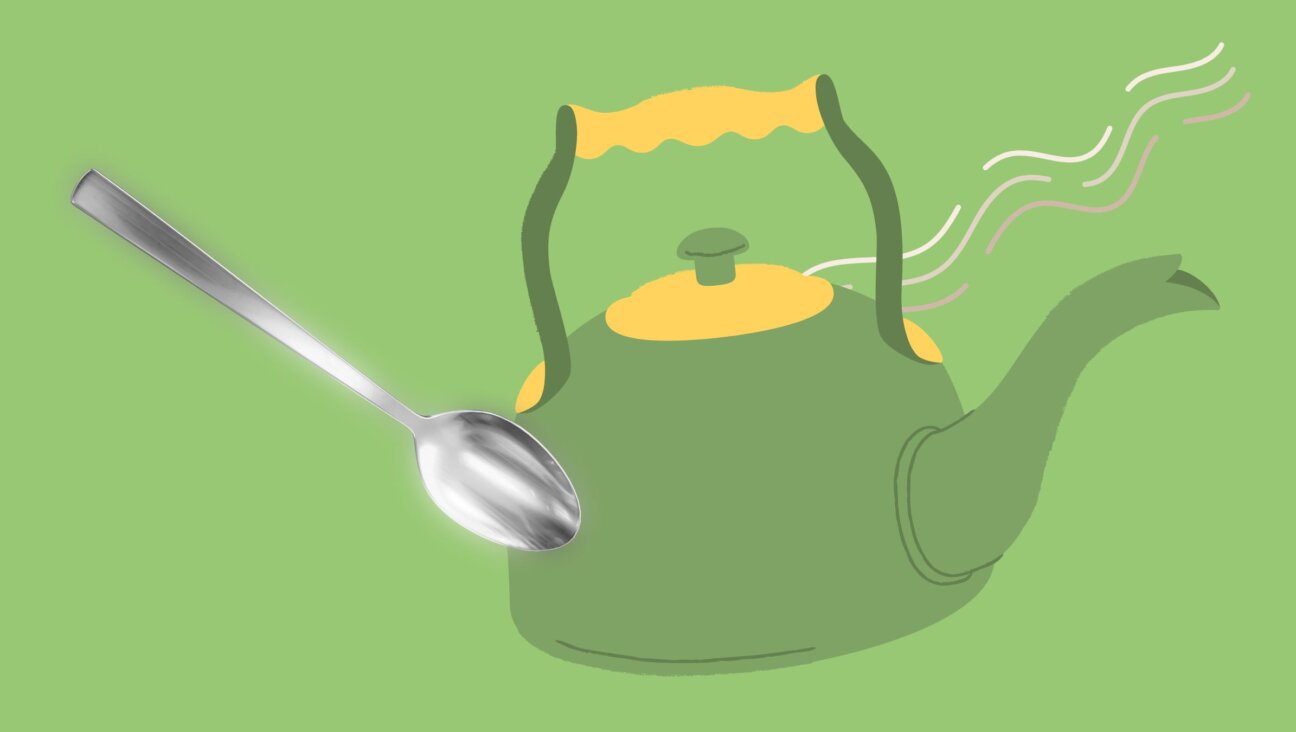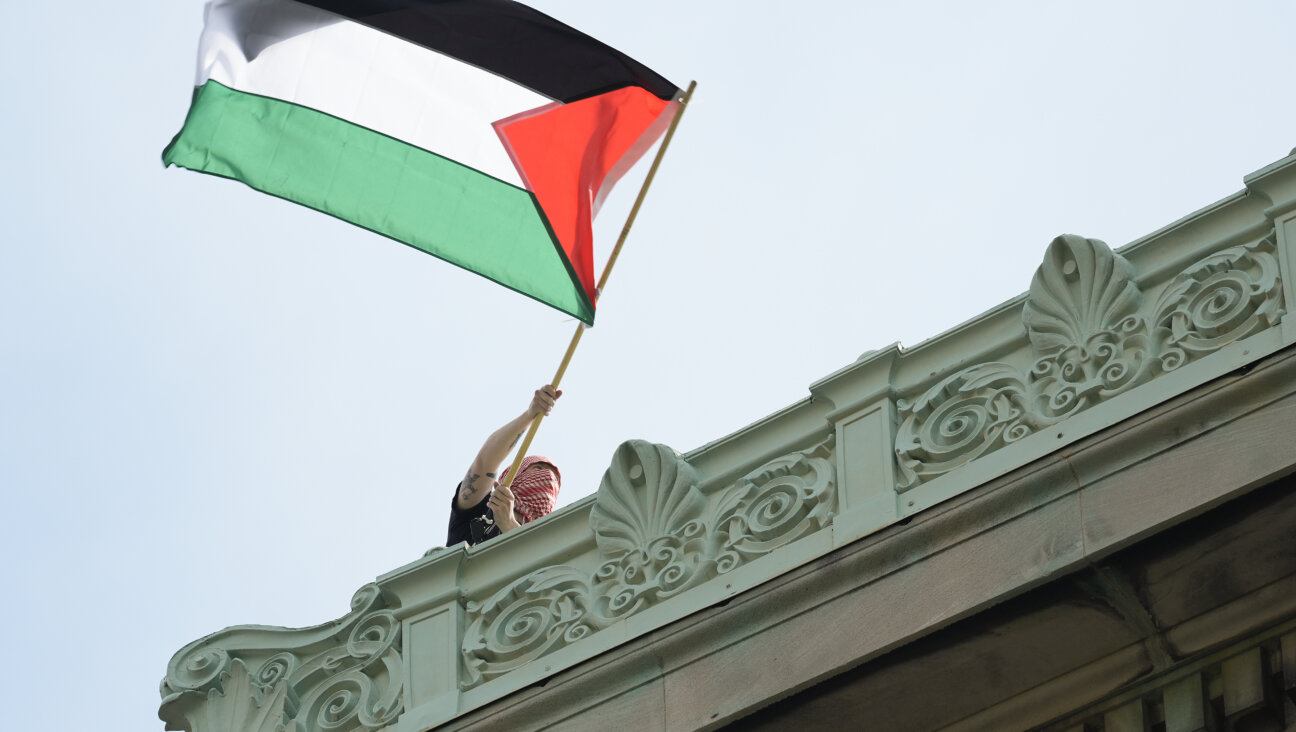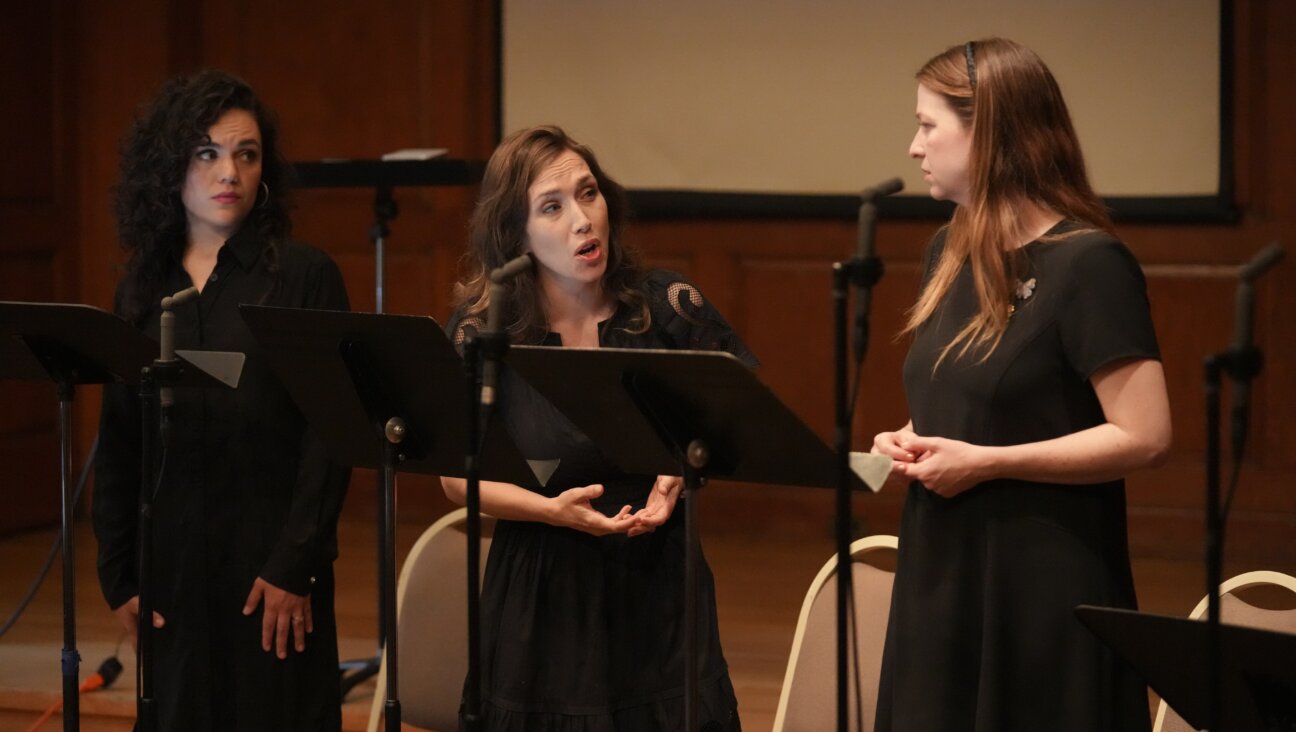In a Kraków Basement, Awkward Objects of Genocide

A fragment of the artwork “Deutsche Fabriken” (1970) by Jan Wojtarowicz. Photograph by Wojciech Wilczyk from his series “Blow-ups.” Image by Courtesy of Erica Lehrer
At the entrance to the temporary exhibition in Esterka’s House, a branch of the Ethnographic Museum in Kraków, there is a photograph of the collections storage of the Warsaw State Ethnographic Museum. The photograph shows rows of densely populated shelves: in the space of just a few cubic meters, hundreds of hand-carved figurines are consorting. There are peasants and priests, farmers and nuns, Adam and Eve and la pieta. And in the center of one row in the back, half-hidden by pastoral and religious scenes, is a triptych of the Holocaust: a soldier shoots a woman and her child, corpses are loaded into ovens, a group of Jews is led away by smiling policemen.
This is how we arrive at “Terribly Close: Polish Vernacular Artists Face the Holocaust.” The exhibition grew out of three years of research conducted by its curators, Erica Lehrer, Roma Sendyka, Magdalena Zych, and Wojciech Wilczyk, who crisscrossed Poland in search of folk art that “intentionally or by chance” contained representations of the Holocaust. “These awkward objects,” as the introductory text calls them, were made between 1948 and 2017. They depict deportations, forced labor, executions; they are unsettling, perplexing, and, at times, deeply empathic.
From the first photograph of the collections storage, the curators include us in their search: we look upon a sea of Polish vernacular art, and our gaze catches on the objects that are not quite right. In fact, there is a participatory element to the entire exhibition. Visitors can rifle through acquisition cards, page through photocopied articles and interviews. In one section, called “Workshop,” six artworks are displayed on tables alongside texts and images that might inform our interpretation of the works. The wall text asks us: “Who made these works, and why?” and “How should we look at them today?”

A fragment of the artwork “Oświęcim” (1962) by Zygmunt Skrętowicz. Photograph by Wojciech Wilczyk from his series “Blow-ups.” Courtesy of Erica Lehrer. Image by Courtesy of Erica Lehrer
Through the exhibition, we see the various ways narratives of the Holocaust have been woven into Polish folk culture. Sometimes it’s a small juxtaposition: in Zygmunt Skrętowicz’s Oświęcim (1962), for example, animals and plants, common in woodcarvings, decorate the scenes of violence. In a more significant reshuffling, Jan Wojtarowicz’s Deutsche Fabriken (ca. 1970) shows a concentration camp scene modeled on a szopka, a Polish nativity scene. Mary and Joseph have been replaced by Nazi officers, the manger by a crematorium, baby Jesus by a corpse being slid into the oven. Even Balthazar, one of the Wise Men usually depicted in szopki as darker-skinned, is represented here as a prisoner carved of slightly browner wood, a pickaxe lying at his feet.
Other works rely on similar Christian iconography: Adam Zegadło’s “Shared Work, Shared Burden” (1969) depicts two Jews carrying a cross; in Edmund Zieliński’s “Got Mit Uns” (ca. 1980), Jesus is led away between a German policeman and SS officer. And in the most recent work in the exhibition, Jedwabne (2017) by Jan Kowalczyk, the mass murder of Jews in Jedwabne is carried out by a frowning, goat-hooved, red-cheeked Devil. (It’s not entirely obvious from the work, actually, if the Devil is meant to be seen as the perpetrator of the crime, or if he’s welcoming the unbaptized Jews to Hell.) Are these examples of the Holocaust made universal, or the scrubbing of Jewishness from works about Jews? To add another layer of complication, Got Mit Uns and Jedwabne are among several works in the exhibition commissioned by German collectors, and it’s unclear how much of their context was determined by the artists and how much by the collectors.
Many of the works are crude, both physically and in subject matter. There are Jews burned alive, chimneys furious with smoke. All the horrible things you might imagine when you think about the Holocaust are here. Władysław Chajec’s Hitlerowcy (“Nazis,” 1967) is a particularly dark pairing: one Nazi rapes a prisoner whose hands are chained to the ground, while another drowns a baby in a well.
The artworks in the exhibition operate at a curious precipice: Many contain the most extreme and most obvious acts of Holocaust violence, with few attempts at subtlety or restraint. They are vulgar and loud, bloody and crass. And yet, there is something rare and intriguing about them, something quiet and hard to articulate: they are shocking works, sure, but they are also surprising. Maybe it’s the context in which most of these pieces were made. Untrained, non-Jewish artists have depicted the murder of the Jews for an almost entirely non-Jewish audience during a time in which the Communist government suppressed most discussion of the specifically Jewish nature of the Holocaust. Maybe it’s just that the objects are clumsy, cartoonish. (In Hitlerowcy, the only reason we know it’s a well the baby is being drowned in and not a barrel is because the object is labeled “well” in Polish.) The works were also rarely made with a consideration for form: Chajec rendered his violent scenes as woodcarvings because he was a woodcarver; Franciszek Wacek’s “Corpse-Carrier” (1967) resembles a toy truck because Wacek was a toymaker. The artists don’t adapt their media to the subject matter, but rather absorb the subject into whatever form they are already working in. The effect is that there is a bluntness to them, a matter-of-factness that speaks of daily life. Going through the exhibition, this quiet, under-layer of the pieces starts to take hold, the things that might be said around and through the graphic depictions of violence.
It’s an apt time for the exhibition to take place. In past years, there have been many international news stories about how Judaism and the Holocaust are treated in Poland. The Independence March in 2017 was noted for its anti-Semitic slogans, Poland’s ‘Holocaust law’ was widely condemned last year, and there has been recent controversy over comments made by the Israeli foreign minister about Polish anti-Semitism. The works in this exhibition offer less publicized Polish perspectives on Jews and the Holocaust: how non-Jewish Poles in former shtetls contended with the murder of their Jewish neighbors, how the Nazi occupation could be depicted during Communism, and how Polish representations of the Holocaust have changed over time.
“I think we began tantalized by the idea that these objects might serve as windows into local Polish peasant ‘bystander’ memory of Jewish wartime suffering,” writes Dr. Lehrer, one of the curators, by email. An anthropologist and curator, Dr. Lehrer has long researched depictions of Jews in Polish folk culture. “Now, rather than viewing them as only, or directly symptoms of the condition of Polish memory, we realize that they were effects of many different cultural, political, and economic forces intertwining, including German and foreign Jewish memorial needs.”
The why of the works is a difficult thing to extricate. There are quotations from several of the artists that suggest they did not want to let the Holocaust or pre-war Jewish culture fade from memory. In a video, painter Adam Czarnecki says of a deportation of Jews to Treblinka that he witnessed: “It felt so bad to me like, I went and painted it. And so I have this keepsake.”
But it’s hard to take Czarnecki’s comment at face value. The curators discovered, just two weeks before the exhibition, that Czarnecki served in the National Armed Forces, a nationalist partisan unit noted for its persecution of Jews during the war. The text in front of Czarnecki’s painting earlier in the exhibition, “Jews Get to Work” (1967), says that while the painting can be read as an expression of sympathy, it also evokes “the anti-Semitic stereotype that Jews shied away from hard work. The depiction of forced manual labor could thus be interpreted instead as a kind of symbolic revenge, a squaring of accounts.”
Attempts to interpret the forces behind the works are themselves complicated, and sometimes more perplexing than the actual artworks. The video in which Czarnecki speaks, Ślady, was filmed in 1967 by Andrzej Brzozowski, but suppressed by the Communist government following the Six Day War and not completed and released until 1982. Ostensibly about the representations of Jews in Polish folk art and the artists’ motives, it intercuts artist interviews with shots of Zegadło’s carvings. In one particularly beguiling moment, a carving of a Jewish man reaches for his wife’s breast—at least, she seems to be his wife, though she is much smaller than he, and her bed resembles a crib. As we watch them, a red wooden rooster is carried, inexplicably, across the frame.
Another way the exhibition attempts to parse the riddle of artistic intentions is through a series of photographs called “Blow-ups,” taken by Wojciech Wilczyk. “Blow-ups” are close-up photographs of some of the figures in the artworks that, by magnifying details that would otherwise be invisible, let us view the objects from the perspective of their makers. One particularly striking example is a photograph of an SS officer carved by Krzystof Osak: the officer is wide-eyed, his lips bent into a slight frown. He looks scared, and the paint smudged under his left eye resembles mascara after a short cry. It is, needless to say, not an expression we usually associate with SS officers, but whether it was intentional or not is impossible to say.
Several works are displayed alongside their “Blow-ups,” often changing how you view the originals. The “Blow-up” of “Jews Get to Work” focuses on a patch of canvas in which a Jew, partially hidden by a building, watches the scene of other Jews being forced into labor. In the photograph, the divots in the canvas not filled with paint look like bullet holes, a moth-eaten sweater; the Jew’s arm dematerializes into a single grey stroke. Looking at the original, it’s as if the entire painting now hinges on this swatch, the whole image rearranging itself around it.
The influence of the curators is most apparent in the exhibition’s final room, titled “Emotions,” which contains the works that, according to Dr. Lehrer, the curators “found most empathic.” The works in this room are certainly compelling—an abstract sculpture, “Gas” (1969), especially comes to mind—and several seem to take on the perspective of Jewish victims. But it’s an odd distinction to draw, denoting some works as particularly empathic — does it mean the others are not? — and we can feel the curators nudging us toward a reaction we might not necessarily share.
This recalls another awkward distinction the curators make through the exhibition, the one between Jewish victimhood and Polish witnessing. All the artworks, we’re told, depict the Holocaust, the fate of Polish Jews, but what about Hitlerowcy is specifically Jewish? Where are the Jews in Deutsche Fabriken, the concentration camp nativity scene? Franciszek Skocz, whose series “Camp” (ca. 1978) is one of the first works in the exhibition, is introduced as a witness of the Holocaust. But Skocz himself spent several years as a prisoner in Auschwitz—isn’t he also a victim? The curators are upfront about their focus on Jewish narratives, and perhaps it speaks to the inseparability of non-Jewish and Jewish fates in Poland that they cannot be cleanly delineated. Still, it’s a question that hangs unanswered through the exhibition, and, depending on your relationship to Polish wartime suffering, it may range from slightly distracting to a gross oversight.
The final image of the exhibition is a “Blow-up” of the three figurines from Józef Piłat’s “Jewish Shop in Dębska Wola” (1964). They are among the few carved figures in the exhibition whose names are given — Piłat knew the family and carved them from memory. Taking up nearly the entire wall, these three faces seem impossibly delicate, pitted and worn. It is a deeply affecting end to this extraordinary and unnerving exhibition. The images are accompanied by a poem by Tomasz Gajda, a friend of the artist:
> Everything is gone.
That whole world has waned.
Only Piłat’s carving
forever still remains.
“Terribly Close: Polish Vernacular Artists Face the Holocaust” was on display December 1, 2018–March 31, 2019 at the Ethnographic Museum in Kraków. A book about the research behind the exhibition, and with the same title, is forthcoming.

I hope you appreciated this article. Before you go, I’d like to ask you to please support the Forward’s award-winning, nonprofit journalism during this critical time.
Now more than ever, American Jews need independent news they can trust, with reporting driven by truth, not ideology. We serve you, not any ideological agenda.
At a time when other newsrooms are closing or cutting back, the Forward has removed its paywall and invested additional resources to report on the ground from Israel and around the U.S. on the impact of the war, rising antisemitism and the protests on college campuses.
Readers like you make it all possible. Support our work by becoming a Forward Member and connect with our journalism and your community.
Make a gift of any size and become a Forward member today. You’ll support our mission to tell the American Jewish story fully and fairly.
— Rachel Fishman Feddersen, Publisher and CEO
Join our mission to tell the Jewish story fully and fairly.






















